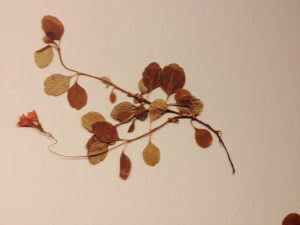I have long had a soft spot for twinflower (Linnaea borealis). For 3 years in the late 70s I climbed almost daily up to my research plots in the native pinewood at Glen Tanar and there between them, to my constant delight, was a big area of twinflower. I believe the fenced plots remain there today but I don’t know how that twinflower has faired – it seems to becoming increasingly elusive in Scotland.
This week it was a joy to see another big patch of twinflower in the middle of our new exhibition on the botanical collections of John Muir, Natures Beloved Son. As the name borealis suggests Linnaea is circumpolar, with populations in North America as well as Northern Europe. Muir collected this specimen in Ontario but he also found it, while in the company of the great botanist Sir Joseph Hooker, on the banks of ‘one of the icy-cold branches of the Sacramento river’ the first time the blessed plant (as Muir called it) had been recorded in California.
Linnaea is, of course, named after another famous naturalist, Carl Linne, who described it, perhaps with tongue in cheek, as ‘… a plant of Lapland, lowly, insignificant, disregarded, flowering but for a brief space – after Linnaeus who resembles it’. The modesty associated with this lovely but ephemeral flower is perhaps why the girl’s name Linnea has become so popular in Scandinavia, regularly sitting near the top of the charts in both Norway and Sweden in recent years.![]()


2 Comments
2 Pingbacks